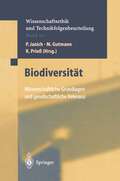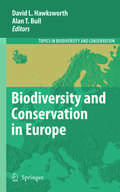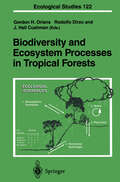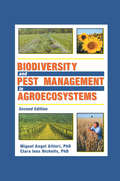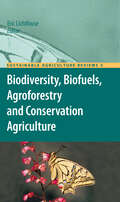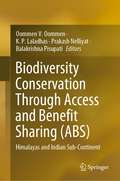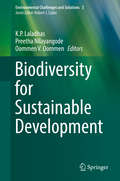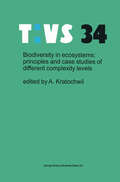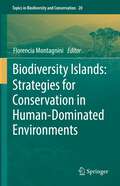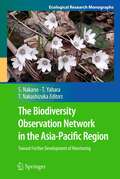- Table View
- List View
Biodiesel Fuels Based on Edible and Nonedible Feedstocks, Wastes, and Algae: Science, Technology, Health, and Environment (Handbook of Biodiesel and Petrodiesel Fuels)
by Ozcan KonurThis second volume of the Handbook of Biodiesel and Petrodiesel Fuels presents a representative sample of the population papers in the field of feedstock-specific biodiesel fuels. The research on feedstocks for biodiesel fuels has first focused on the edible oils as first-generation biodiesel fuels. However, the public concerns about the competition with foods based on these feedstocks and adverse impact on the ecological diversity and deforestation have resulted in the exploration of nonedible-oil-based biodiesel fuels as second-generation biodiesel fuels in the first instance. Due to the ecological and cost benefits of treating wastes, waste oil-based biodiesel fuels as third-generation biodiesel fuels have emerged. Furthermore, following a series of influential review papers, the research has focused on the algal oil-based biodiesel fuels in recent years. Since the cost of feedstocks in general constitutes 85% of the total biodiesel production costs, the research focused more on improving biomass and lipid productivity in these research fields. Furthermore, since water, CO2, and nutrients (primarily N and P) have been major ingredients for the algal biomass and lipid production, the research has also intensified in the use of wastewaters and flue gases for algal biomass production to reduce the ecological burdens and the production costs. Part 1 presents a representative sample of the population papers in the field of edible oil-based biodiesel fuels covering major research fronts. It covers soybean oil-based biodiesel fuels, palm oil-based biodiesel fuels, and rapeseed oil-based biodiesel fuels as case studies besides an overview paper. Part 2 presents a representative sample of the population papers in the field of nonedible oil-based biodiesel fuels covering major research fronts. It covers Jatropha oil-based biodiesel fuels, polanga oil-based biodiesel fuels, and moringa oil-based biodiesel fuels as case studies besides an overview paper. Part 3 presents a representative sample of the population papers in the field of waste oil-based biodiesel fuels covering major research fronts. It covers wastewater sludge-based biodiesel fuels, waste cooking oil-based biodiesel fuels, and microbial oil-based biodiesel fuels as case studies besides an overview paper. Part 4 presents a representative sample of the population papers in the field of algal oil-based biodiesel fuels covering major research fronts. It covers algal biomass production in general, algal biomass production in wastewaters, algal lipid production, hydrothermal liquefaction of algal biomass, algal lipid extraction, and algal biodiesel production besides an overview paper. This book will be useful to academics and professionals in the fields of Energy Fuels, Chemical Engineering, Physical Chemistry, Biotechnology and Applied Microbiology, Environmental Sciences, and Thermodynamics. Ozcan Konur is both a materials scientist and social scientist by training. He has published around 200 journal papers, book chapters, and conference papers. He has focused on the bioenergy and biofuels in recent years. In 2018, he edited ‘Bioenergy and Biofuels’, that brought together the work of over 30 experts in their respective field. He also edited ‘Handbook of Algal Science, Technology, and Medicine’ with a strong section on the algal biofuels in 2020.
Biodiesel Fuels Based on Edible and Nonedible Feedstocks, Wastes, and Algae: Science, Technology, Health, and Environment (Handbook of Biodiesel and Petrodiesel Fuels)
by Ozcan KonurThis second volume of the Handbook of Biodiesel and Petrodiesel Fuels presents a representative sample of the population papers in the field of feedstock-specific biodiesel fuels. The research on feedstocks for biodiesel fuels has first focused on the edible oils as first-generation biodiesel fuels. However, the public concerns about the competition with foods based on these feedstocks and adverse impact on the ecological diversity and deforestation have resulted in the exploration of nonedible-oil-based biodiesel fuels as second-generation biodiesel fuels in the first instance. Due to the ecological and cost benefits of treating wastes, waste oil-based biodiesel fuels as third-generation biodiesel fuels have emerged. Furthermore, following a series of influential review papers, the research has focused on the algal oil-based biodiesel fuels in recent years. Since the cost of feedstocks in general constitutes 85% of the total biodiesel production costs, the research focused more on improving biomass and lipid productivity in these research fields. Furthermore, since water, CO2, and nutrients (primarily N and P) have been major ingredients for the algal biomass and lipid production, the research has also intensified in the use of wastewaters and flue gases for algal biomass production to reduce the ecological burdens and the production costs. Part 1 presents a representative sample of the population papers in the field of edible oil-based biodiesel fuels covering major research fronts. It covers soybean oil-based biodiesel fuels, palm oil-based biodiesel fuels, and rapeseed oil-based biodiesel fuels as case studies besides an overview paper. Part 2 presents a representative sample of the population papers in the field of nonedible oil-based biodiesel fuels covering major research fronts. It covers Jatropha oil-based biodiesel fuels, polanga oil-based biodiesel fuels, and moringa oil-based biodiesel fuels as case studies besides an overview paper. Part 3 presents a representative sample of the population papers in the field of waste oil-based biodiesel fuels covering major research fronts. It covers wastewater sludge-based biodiesel fuels, waste cooking oil-based biodiesel fuels, and microbial oil-based biodiesel fuels as case studies besides an overview paper. Part 4 presents a representative sample of the population papers in the field of algal oil-based biodiesel fuels covering major research fronts. It covers algal biomass production in general, algal biomass production in wastewaters, algal lipid production, hydrothermal liquefaction of algal biomass, algal lipid extraction, and algal biodiesel production besides an overview paper. This book will be useful to academics and professionals in the fields of Energy Fuels, Chemical Engineering, Physical Chemistry, Biotechnology and Applied Microbiology, Environmental Sciences, and Thermodynamics. Ozcan Konur is both a materials scientist and social scientist by training. He has published around 200 journal papers, book chapters, and conference papers. He has focused on the bioenergy and biofuels in recent years. In 2018, he edited ‘Bioenergy and Biofuels’, that brought together the work of over 30 experts in their respective field. He also edited ‘Handbook of Algal Science, Technology, and Medicine’ with a strong section on the algal biofuels in 2020.
Biodiesel Production: Feedstocks, Catalysts, and Technologies
by Samuel Lalthazuala Rokhum Gopinath Halder Suttichai Assabumrungrat Kanokwan NgaosuwanAn incisive discussion of biofuel production from an economically informed technical perspective that addresses sustainability and commercialization together In Biodiesel Production: Feedstocks, Catalysts and Technologies, renowned chemists Drs Rokhum, Halder, Ngaosuwan and Assabumrungrat present an up-to-date account of the most recent developments, challenges, and trends in biodiesel production. The book addresses select feedstocks, including edible and non-edible oils, waste cooking oil, microalgae, and animal fats, and highlights their advantages and disadvantages from a variety of perspectives. It also discusses several catalysts used in each of their methods of preparation, as well as their synthesis, reactivity, recycling techniques, and stability. The contributions explore recently developed technologies for sustainable production of biodiesel and provides robust treatments of their sustainability, commercialization, and their prospects for future biodiesel production. A thorough introduction to the various catalysts used in the preparation of biodiesel and their characteristics Comprehensive explorations of biofuel production from technical and economic perspectives, with complete treatments of their sustainability and commercialization Practical discussions of the development of new strategies for sustainable and economically viable biodiesel production In-depth examinations of biodiesel feedstocks, catalysts, and technologiesPerfect for academic researchers and industrial scientists working in fields that involve biofuels, bioenergy, catalysis, and materials science, Biodiesel Production: Feedstocks, Catalysts and Technologies will also earn a place in the libraries of bioenergy regulators.
Biodiesel Production: Feedstocks, Catalysts, and Technologies
by Samuel Lalthazuala Rokhum Gopinath Halder Suttichai Assabumrungrat Kanokwan NgaosuwanAn incisive discussion of biofuel production from an economically informed technical perspective that addresses sustainability and commercialization together In Biodiesel Production: Feedstocks, Catalysts and Technologies, renowned chemists Drs Rokhum, Halder, Ngaosuwan and Assabumrungrat present an up-to-date account of the most recent developments, challenges, and trends in biodiesel production. The book addresses select feedstocks, including edible and non-edible oils, waste cooking oil, microalgae, and animal fats, and highlights their advantages and disadvantages from a variety of perspectives. It also discusses several catalysts used in each of their methods of preparation, as well as their synthesis, reactivity, recycling techniques, and stability. The contributions explore recently developed technologies for sustainable production of biodiesel and provides robust treatments of their sustainability, commercialization, and their prospects for future biodiesel production. A thorough introduction to the various catalysts used in the preparation of biodiesel and their characteristics Comprehensive explorations of biofuel production from technical and economic perspectives, with complete treatments of their sustainability and commercialization Practical discussions of the development of new strategies for sustainable and economically viable biodiesel production In-depth examinations of biodiesel feedstocks, catalysts, and technologiesPerfect for academic researchers and industrial scientists working in fields that involve biofuels, bioenergy, catalysis, and materials science, Biodiesel Production: Feedstocks, Catalysts and Technologies will also earn a place in the libraries of bioenergy regulators.
Biodiesel Production with Green Technologies
by Aminul Islam Pogaku RavindraThis book provides a single-source reference to green technologies in advanced biofuel technology. The main focus is on the description of the state of the art in catalytic processes for the "green" production of biofuels. The authors describe two different, practical approaches for catalysts, which allow for effective and easy separation of the catalyst by simple filtration, and enable reuse for several cycles. Readers will gain understanding as to the mechanisms involved in the synthesis and structure formation of the catalyst, in order to maximize yield of biodiesel production. The authors also address the question of how catalytic material should be distributed inside a porous support to obtain optimal performance. The effects of physicochemical and operating parameters are analyzed to gain insight into the underlying phenomena governing the performance of optimally designed catalysts.
Biodiversität: Wissenschaftliche Grundlagen und gesetzliche Relevanz (Ethics of Science and Technology Assessment #10)
by F. WütscherDie interdisziplinär besetzte Projektgruppe Biodiversität der Europäischen Akademie Bad Neuenahr-Ahrweiler hat sich die Aufgabe gestellt, den wissenschaftlichen Sachstand aus den verschiedenen Disziplinen zusammenzutragen und die diversen, auf der Grundlage fachspezifischer Methoden entwickelten Konzepte gemeinsam zu untersuchen.In den in diesem Band versammelten Ergebnissen finden sich entsprechend neben den rein naturwissenschaftlichen auch relevante erkenntnis- und wissenschaftstheoretische Fragen sowie juristische und ökonomische Aspekte diskutiert. Damit bietet das Buch einen guten Überblick über den Diskussionsstand und eine solide Grundlage für die weitere wissenschaftliche Diskussion.
Biodiversity and Conservation in Europe (Topics in Biodiversity and Conservation #7)
by David L. Hawksworth Alan T. BullThis book brings together a selection of original studies that address biodiversity and conservation in Europe. The contributions are drawn from a wide range of countries and discuss diverse organism and habitat types. They collectively provide a snap-shot of the sorts of studies and actions being taken in Europe to address issues in biodiversity and conservation – topical examples that make the volume especially valuable for use in conservation biology courses.
Biodiversity and Conservation of Woody Plants (Sustainable Development and Biodiversity #17)
by M. R. Ahuja S. Mohan JainThis book provides complete, comprehensive, and broad subject-based reviews for students, teachers, researchers, policymakers, conservationists, and NGOs interested in the biodiversity and conservation of woody plants.Forests cover approximately 31 percent of the world’s total landmass; 93 percent is natural forest and only 7 percent consists of planted trees. Forest decline is progressing at an alarming rate worldwide. In addition to human activities (logging, deforestation, and exploiting forest lands for agriculture and industrial use), a number of other factors – including pests and diseases, drought, soil acidity, radiation, and ozone – are cumulatively contributing to global forest decline. The present situation forces us to focus on forest conservation strategies for the present and future. Gene conservation and maintaining genetic diversity in forest ecosystems are crucial to the preservation of forest genetic resources. This calls for integrated action to implement both the in situ (on site) preservation of forest stands and ex situ (distant from the original site) strategies for the conservation of woody plants’ genetic resources. Selected priority areas include: 1) assessing patterns of genetic diversity and threats, 2) understanding the biological processes regulating genetic diversity, 3) assessing the impact of human activities and climate change on genetic diversity, and 5) finding methods for prioritizing species and populations for the conservation of forest trees genetic resources.All chapters were written by leading scientists in their respective fields, which include: woody plant diversity, ecology and evolution; assessment of genetic diversity in forest tree populations; conservation planning under climate change; and in situ and ex situ strategies, including biotechnological approaches, for the conservation of woody plants genetic resources.
Biodiversity and Ecosystem Function (Springer Study Edition Ser.)
by Ernst-Detlef Schulze Harold A. MooneyThe biota of the earth is being altered at an unprecedented rate. We are witnessing wholesale exchanges of organisms among geographic areas that were once totally biologically isolated. We are seeing massive changes in landscape use that are creating even more abundant succes sional patches, reductions in population sizes, and in the worst cases, losses of species. There are many reasons for concern about these trends. One is that we unfortunately do not know in detail the conse quences of these massive alterations in terms of how the biosphere as a whole operates or even, for that matter, the functioning of localized ecosystems. We do know that the biosphere interacts strongly with the atmospheric composition, contributing to potential climate change. We also know that changes in vegetative cover greatly influence the hydrology and biochemistry ofa site or region. Our knowledge is weak in important details, however. How are the many services that ecosystems provide to humanity altered by modifications of ecosystem composition? Stated in another way, what is the role of individual species in ecosystem function? We are observing the selective as well as wholesale alteration in the composition of ecosystems. Do these alterations matter in respect to how ecosystems operate and provide services? This book represents the initial probing of this central ques tion. It will be followed by other volumes in this series examining in depth the functional role of biodiversity in various ecosystems of the world.
Biodiversity and Ecosystem Processes in Tropical Forests (Ecological Studies #122)
by Gordon H. Orians Rodolfo Dirzo J. Hall CushmanAlthough biologists have directed much attention to estimating the extent and causes of species losses, the consequences for ecosystem functioning have been little studied. This book examines the impact of biodiversity on ecosystem processes in tropical forests - one of the most species-rich and at the same time most endangered ecosystems on earth. It covers the relationships between biodiversity and primary production, secondary production, biogeochemical cycles, soil processes, plant life forms, responses to disturbance, and resistance to invasion. The analyses focus on the key ecological interfaces where the loss of keystone species is most likely to influence the rate and stability of ecosystem processes.
Biodiversity and Pest Management in Agroecosystems
by Miguel Altieri Clara NichollsExplore the latest research on biological control! Completely updated for 2004, this new edition examines methods for making agricultural systems less susceptible to insect pests. Containing new findings and reports of strategies, Biodiversity and Pest Management in Agroecosystems, Second Edition will show you how pests can be managed by enhancing beneficial biodiversity using agroecological diversification methods. Biodiversity and Pest Management in Agroecosystems, Second Edition provides you with an essential overview of the role of biodiversity in agriculture and then gets specific, with new and updated information on: the agroecology of pest management plant diversity and pest outbreaks within agroecosystems diversification strategies for pest management how sustainable farming systems are designed You'll also explore: the role of plant diversity on the biology of beneficial insects insect regulation in diverse agroecosystems manipulation of plant diversity in agroecosystems ecological and socioeconomic implications The fact is, many modern agroecosystems are unstable as a consequence of constant human intervention in crop systems which ignore ecological principles. With case studies on a variety of crops and pests, Biodiversity and Pest Management in Agroecosystems, Second Edition explores entomological aspects of agriculture and analyzes the ecological basis for the maintenance of biodiversity. It will familiarize you with the theory and practice of enhancing biological pest control in agricultural systems by managing vegetational diversity via multiple cropping, cover cropping, rotations, and other spatial and temporal designs. With studies on intercropping, cover cropping, weed management, and crop-field border vegetation manipulation, this book covers the effects of these diverse systems on pest population density and the mechanisms underlying pest reduction in polycultures. Make it a part of your reference/teaching collection today!
Biodiversity and Pest Management in Agroecosystems
by Miguel Altieri Clara NichollsExplore the latest research on biological control! Completely updated for 2004, this new edition examines methods for making agricultural systems less susceptible to insect pests. Containing new findings and reports of strategies, Biodiversity and Pest Management in Agroecosystems, Second Edition will show you how pests can be managed by enhancing beneficial biodiversity using agroecological diversification methods. Biodiversity and Pest Management in Agroecosystems, Second Edition provides you with an essential overview of the role of biodiversity in agriculture and then gets specific, with new and updated information on: the agroecology of pest management plant diversity and pest outbreaks within agroecosystems diversification strategies for pest management how sustainable farming systems are designed You'll also explore: the role of plant diversity on the biology of beneficial insects insect regulation in diverse agroecosystems manipulation of plant diversity in agroecosystems ecological and socioeconomic implications The fact is, many modern agroecosystems are unstable as a consequence of constant human intervention in crop systems which ignore ecological principles. With case studies on a variety of crops and pests, Biodiversity and Pest Management in Agroecosystems, Second Edition explores entomological aspects of agriculture and analyzes the ecological basis for the maintenance of biodiversity. It will familiarize you with the theory and practice of enhancing biological pest control in agricultural systems by managing vegetational diversity via multiple cropping, cover cropping, rotations, and other spatial and temporal designs. With studies on intercropping, cover cropping, weed management, and crop-field border vegetation manipulation, this book covers the effects of these diverse systems on pest population density and the mechanisms underlying pest reduction in polycultures. Make it a part of your reference/teaching collection today!
Biodiversity, Biofuels, Agroforestry and Conservation Agriculture (Sustainable Agriculture Reviews #5)
by Eric LichtfouseSustainable agriculture is a rapidly growing field aiming at producing food and energy in a sustainable way for our children. This discipline addresses current issues such as climate change, increasing food and fuel prices, starvation, obesity, water pollution, soil erosion, fertility loss, pest control and biodiversity depletion. Novel solutions are proposed based on integrated knowledge from agronomy, soil science, molecular biology, chemistry, toxicology, ecology, economy, philosophy and social sciences. As actual society issues are now intertwined, sustainable agriculture will bring solutions to build a safer world. This book series analyzes current agricultural issues, and proposes alternative solutions, consequently helping all scientists, decision-makers, professors, farmers and politicians wishing to build safe agriculture, energy and food systems for future generations.
Biodiversity Conservation: Problems and Policies (Ecology, Economy & Environment #4)
by Charles A. Perrings Karl-Göran Mäler Carl Folke C. S. Holling Beng-Owe JanssonBiodiversity Conservation Through Access and Benefit Sharing (ABS): Himalayas and Indian Sub-Continent
by K. P. Laladhas Oommen V. Oommen Prakash Nelliyat Balakrishna PisupatiThis book deals with the economic potentials of biodiversity and its capacity to support its own conservation aiming to provide livelihood for millions engaged in conservation, both now and for future generations. The book highlights the potentials of natural resources which are characterized as capital wealth (as defined in Convention on Biological Diversity (CBD)), to finance its own conservation and to provide livelihood means to people who conserve it.The book is divided into five Parts. PART I explains about the Premise of Access and Benefit Sharing (ABS), PART II describes about the Technology Transfer, PART III will provide details about the Access to Genetic Resources and to Associated Traditional Knowledge and Benefit Sharing PART IV is the Implementation of ABS Mechanisms and PART V is about ABS and Its Economics.This book will be of interest to biodiversity policy makers, administrators, university and college students, researchers, biodiversity conservationists.
Biodiversity for Sustainable Development (Environmental Challenges and Solutions #3)
by K. P. Laladhas Preetha Nilayangode Oommen V. OommenDivided into three sections, this book explores the three main pillars of sustainable development, namely economy, environment and society, and their interlinkages at the regional level. The first section, Access and Benefit Sharing (ABS) for sustainable development, focuses on international agreements and national legislation, as well as the challenges in implementing ABS in e.g. India. In turn, the second section examines the process of forming Biodiversity Management Committees (BMCs) at the Local Self Government (LSG) level to promote environmental sustainability, highlighting local and community-level conservation initiatives that have led to the conservation of habitats and species. The third section addresses poverty eradication and food security. The case studies included demonstrate how the combination of traditional knowledge and modern techniques can enhance the productivity of traditional crop varieties, yielding greater benefits for communities. The aim of this volume is to disseminate the lessons learned from these case studies, as well as the findings from projects already in place, which can offer recommendations that can be applied to similar problems elsewhere in an attempt to find environmental solutions for sustainable development. Further, it introduces readers to new approaches to inclusive development, demonstrating that participation and grass root empowerment are key drivers of equitable and sustainable development.
Biodiversity, Functional Ecosystems and Sustainable Food Production
by Charis M. GalanakisIn recent decades, practices like the cultivation of a few high-yielding crop varieties on a large scale, the application of heavy machinery and continued mechanization of agriculture, the removal of natural habitats, and the application of pesticides and synthetics have resulted in the simplification of agro-ecosystems. This has enabled a substantial increase in food production but has at the same time transformed landscapes. Indeed, there is a concern that a decline in biodiversity has affected microbiome activities that support processes across soils, plants, animals, the marine environment, and humans. Although they have increased food production, the above practices cannot be considered sustainable in long-term applications. Biodiversity, Functional Ecosystems, and Sustainable Food Production explore ecosystems in terms of crop and animal production, pest and disease control, nutrient cycling, and soil fertility. Chapters range from agro-biodiversity to antimicrobial use in animal food production to microbiome applications for sustainable food systems and the impacts of environment-friendly unit operations on the functional properties of bee pollen. By examining such topics about each other, the text emphasizes how food production, ecosystem function, food quality, and consumer health are all interconnected.
Biodiversity In Agricultural Production Systems
by Gero Benckiser Sylvia SchnellWhile modern science has always recognized the central role that biodiversity plays in the ecological processes that maintain the Earth's equilibrium, our increasing knowledge of nature has deepened our appreciation of this principle. Consequently, those involved with implementing and maintaining sustainable agriculture systems have begun to take a
Biodiversity in Agriculture: Sustainability of Soil, Soil Fauna and Soil Flora
by Kodoth Prabhakaran NairThis book begins with the principal subject of biodiversity in agriculture. The onslaught of highly soil extractive chemical farming, euphemistically called the “green revolution”, has taken a heavy toll on soil biodiversity, hence, soil sustenance. Agrobiodiversity is a key resource for humanity. All of the food requirements humanity depends on are met by agrobiodiversity. Similarly, fodder fiber, firewood, and many other basic needs of humankind are also met by agrobiodiversity. The book puts forward ideas on how we are to develop a sustainable future, to provide a healthy and thriving environment for humanity by protecting, conserving, and augmenting agrobiodiversity.The pedosphere, the outermost layer of the Earth, composed of soil and subject to soil formation processes, is an integral component of biosphere, lying on the interface of the atmosphere, hydrosphere, and lithosphere and a lot more complex in its physicochemical and biological characteristics and functioning and quite distinguishable from that of the above soil-surface terrestrial and aquatic ecosystems. The biotic component of the pedosphere comprises a rich biodiversity of living species, dominated by microorganisms. This book considers and discusses the influences of soil formation processes.This book will be of interest to those engaged in researching biodiversity, agriculture, and crop science.
Biodiversity in ecosystems: principles and case studies of different complexity levels (Tasks for Vegetation Science #34)
by A. KratochwilThis volume does not aim at merely adding to the vast and increasing number of individual publications on `biodiversity'. Rather it is our objective to investigate biodiversity on the previously little studied coenosis and landscape levels. Phytosociological and animal-ecological fields are considered, as well as theoretical approaches to biodiversity and aspects of its application in nature and landscape protection and preservation. Since biodiversity has so far been predominantly studied in the Anglo-American area, it seemed to be of value to discuss this complex topic from a central and southern European viewpoint, based on data gathered in these regions, and thus to promote a global discussion.
Biodiversity in Enclosed Seas and Artificial Marine Habitats: Proceedings of the 39th European Marine Biology Symposium, held in Genoa, Italy, 21-24 July 2004 (Developments in Hydrobiology #193)
by G. Relini J. RylandThe main themes of the Symposium were biodiversity in enclosed and semi-enclosed seas and artificial habitats, and the restoration of degraded systems. These themes are highly relevant today. The papers dealing with the first theme represent current research and concerns about marine biodiversity in enclosed seas. The papers in the second theme represent a synthesis of up-to-date knowledge on artificial habitats.
Biodiversity Islands: Strategies for Conservation in Human-Dominated Environments (Topics in Biodiversity and Conservation #20)
by Florencia MontagniniThis book is intended to provide an overview for the identification and establishment of biodiversity islands. It presents examples and case studies where the biodiversity islands approach is being used in a variety of locations and contexts worldwide. It will contribute to design parameters on appropriate sizing and spatial distribution of biodiversity islands in order to be effective in conservation and regeneration across the landscape, using integrated landscape management approaches. This book is essential given the current worldwide trend of habitat destruction and the need to preserve biodiversity and its values. The chapters are organized in five sections. The first section provides the introduction. Section 2,3 and 4 discuss the challenges and alternatives of establishment and management, case studies across the globe, safeguarding of the environmental, economic, and social benefits, and the final section offers a conclusion. The contributing authors present views from the academic, the practitioner and the policymaker perspectives, offering alternatives and suggestions for promoting strategies that support biodiversity conservation through intentionally designed frameworks for sustainable forest landscapes. Readers will discover suggestions and concrete examples that can be used by a variety of stakeholders in various settings throughout the world. This book is useful to researchers, farmers, foresters, landowners, land managers, city planners, and policy makers alike.
The Biodiversity Observation Network in the Asia-Pacific Region: Toward Further Development of Monitoring (Ecological Research Monographs)
by Shin-ichi Nakano, Tetsukazu Yahara and Tohru NakashizukaBiological diversity is important for ecosystem function and services, which in turn is essential for human well-being. Under the Convention on Biological Diversity, international efforts have been made to achieve a significant reduction in the current rate of biodiversity loss. The loss continues, however. The Asia-Pacific region includes both developing countries with high biodiversity and developed countries with sophisticated data collection and analyses, but only limited information about the status quo of biodiversity in this region has been available. Many Asia-Pacific countries have rapidly grown their economies and social infrastructures, causing a loss of biodiversity and requiring an urgent mandate to achieve a balance between development and conservation in the region. In December 2009, scientists successfully organized the Asia-Pacific Biodiversity Observation Network in the region, to establish a network for research and monitoring of ecosystems and biodiversity and to build a cooperative framework. The present volume is the first collection of information on biodiversity in the Asia-Pacific and represents a quantum step forward in science that optimizes the synergy between development and biodiversity conservation.
Biodynamic Beekeeping: A Sustainable Way to Keep Happy, Healthy Bees
by Matthias ThunModern beekeeping, influenced by new technologies and breeding methods, has increased honey production but left bee colonies weak and vulnerable to disease. With the alarming decline of the bee population raising concerns about an impending ecological crisis, many beekeepers are seeking a more sustainable way of caring for bees.Biodynamic Beekeeping is the first book to offer practical instruction on caring for bees using biodynamic theories and methods. By considering the influence of the movement of the stars and the planets on the bees' natural habits, biodynamics encourages beekeepers to be more in tune with their bees indicating, for example, the best days on which to inspect colonies or gather honey.This fascinating book offers beekeepers detailed advice and instruction on how to work more holistically, including:the challenges and advantages of breeding queen beeshow to artificially induce swarming to propagae colonieshow to use biodynamic ashing techniques to combat varroa mitesinstructions for making winter-feed according to current biodynamic thinking
Biodynamic Wine Growing: Understanding the Vine and Its Rhythms
by Jean-Michel FlorinWine growers are converting to biodynamic viniculture in record numbers. Some of the world’s best wines are now biodynamic.At its heart, biodynamic viniculture is about understanding the nature of vines and their relationship to the environment. This beautifully illustrated and informative book will be of interest to current biodynamic wine growers and those considering converting to biodynamic methods. It includes: an introduction to the theory of biodynamic viniculture and the Goethean method of observation in relation to vines;practical articles on all aspects of wine growing, including biodiversity, pruning, treating and preventing disease; case studies of biodynamic vineyards from around the world.Biodynamic wine expert Jean-Michel Florin has gathered contributions from biodynamic viniculturists to create a beautiful, full-colour book which is both a celebration of sustainable wine growing and an invaluable guide to the future of wine cultivation.



